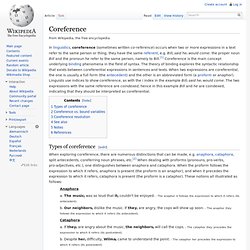

Coreference. Types of coreference[edit] Anaphora a.

The musici was so loud that iti couldn't be enjoyed. - The anaphor it follows the expression to which it refers (its antecedent). b. Our neighborsi dislike the music. Cataphora a. B. Split antecedents a. B. Coreferring noun phrases a. B. Coreference vs. bound variables[edit] Semanticists and logicians sometimes draw a distinction between coreference and what is known as a bound variable.[3] An instance of a bound variable can look like coreference, but from a technical standpoint, one can argue that it actually is not. A. B. Quantified expressions such as every student and no student are, from a technical standpoint, not referential. C. This sentence is ambiguous. Coreference resolution[edit] In computational linguistics, coreference resolution is a well-studied problem in discourse.
A classic problem for coreference resolution in English, is the pronoun it, which has many uses. The Stanford NLP (Natural Language Processing) Group. A Suite of Core NLP Tools About | Citing | Download | Usage | SUTime | Sentiment | Adding Annotators | Caseless Models | Shift Reduce Parser | Extensions | Questions | Mailing lists | Online demo | FAQ | Release history About Stanford CoreNLP provides a set of natural language analysis tools which can take raw text input and give the base forms of words, their parts of speech, whether they are names of companies, people, etc., normalize dates, times, and numeric quantities, and mark up the structure of sentences in terms of phrases and word dependencies, indicate which noun phrases refer to the same entities, indicate sentiment, etc.

Stanford CoreNLP is an integrated framework. Its goal is to make it very easy to apply a bunch of linguistic analysis tools to a piece of text. Citing Stanford CoreNLP If you're just running the CoreNLP pipeline, please cite this CoreNLP demo paper. Download Download Stanford CoreNLP version 3.5.2. GitHub: Here is the Stanford CoreNLP GitHub site. Usage Javadoc. Practical Natural Language Processing Code in C# C# ConceptNetUtils (CNU) Version 2. Introduction ConceptNet¹ is a commonsense knowledgebase, composed mainly from the Open Mind Project, written and put together by Hugo Liu and Push Singh (Media Laboratory Massachusetts Institute of Technology).

ConceptNet 2.1 (current version at the time of this composition) also includes MontyLingua, a natural-language-processing package. ConceptNet is written in Python but it's commonsense knowledgebase is stored in text files. To read more specific details about the complete overview of ConceptNet, read Liu and Singh's outstanding paper (pdf). Most of the projects available from MIT are not written in Microsoft Visual Studio .NET and I am attempting to make use of ConceptNet for educational, research purposes, and just to have fun with the technology involved.
The Visual Studio .NET C# ConceptNetUtils (CNU) Version 2.x Class Library ConceptNetUtils (CNU) version 2 uses IronPython and edited ConceptNet script files to achieve the same results as the Python version of ConceptNet.